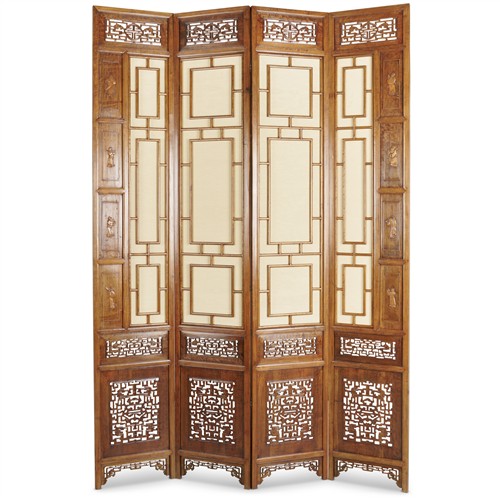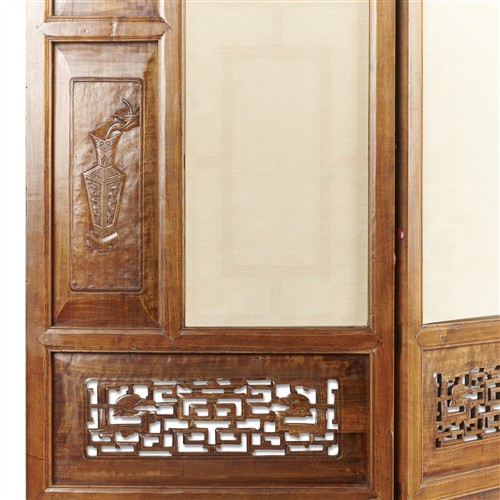Back
A LARGE CHINESE WALNUT FLOOR SCREEN WITH BOXWOOD INLAY QING DYNASTY, 18TH/19TH CENTURY
Standing at an imposing 326 centimetres, this monumental screen would have commanded attention in the most distinguished reception halls of Qing aristocracy, where such pieces served as both functional room dividers and displays of cultural refinement. The size and number of panels were adjusted according to the spatial requirements of each setting.
The primary decorative program centres on geometric latticework panels where calligraphy and paintings could be mounted on both sides for the appreciation of visitors. The principal panels below the lattice mounting space carry the core artistic program that echoes the interior's refined ambience.
On this set of screens, the principal panels are pierced with a continuous key-fret lattice (leiwen 雷紋) centering a large seal-script shou (壽) character for longevity. By recessing the inner motif (陰刻 yinke, concave carving) while keeping the outer frame proud (陽刻 yangke, convex carving), the design echoes an inked seal impression (陽文印痕), creating an effect both visually striking and appropriate to literati taste.
At cardinal points, archaistic kui-dragon (kui long夔龍) scrolls emerge from the meander pattern and curve back upon themselves, their ruyi-headed terminals folding into the grid, while the surrounding rails and apron reprise the key-fret motif with stepped, ruyi-tipped corners.
Together, this decorative program encodes longevity (shou 壽), wish-fulfillment (ruyi 如意), and the protective continuity of the thunder pattern, an auspicious ensemble long favoured for screens intended to preside over formal reception rooms. This decorative scheme is repeated on the smaller carved panels above and the bottom apron, executed with consistent carving techniques throughout.
The boxwood inserts on the end panels depicting the Eight Immortals (Ba Xian 八仙) represents one of the most beloved subjects in Chinese classical literature, opera, and decorative arts.
The exceptional preservation of the boxwood details, with their crisp definition and warm honey-coloured patination, indicates careful custodianship across generations. Such screens were treasured family heirlooms, often passed down through scholarly lineages who understood their cultural significance.
清 核桃木落地屏風。此屏風高達三百二十六公分,巍然聳立,必於清代權貴之顯赫廳堂中奪目生輝,此類器物既為實用之隔屏,亦為文化雅致之展示。屏板大小與數量皆因空間需求而調整,主要裝飾程式以幾何格屏為重,其上可裝裱書畫於正反兩面,供來賓品賞。格屏下方之主板承載核心藝術主題,與室內雅緻氛圍相呼應。
此組屏風之主板飾以連續雷紋格屏,中央嵌大篆壽字以祈長壽。內紋稍陷(陰刻),外框凸起(陽刻),設計仿陽文印痕之效,既視覺醒目,又合文人品味。四隅出夔龍卷雲由回紋中生發,末作如意雲頭折入格欄;周框與下檐復以階式雷紋及如意角收束。整體寓長壽(壽)、稱心(如意)與連綿護佑(雷紋)之意,為主理廳堂者所素尚之吉題。此裝飾程式於上方小鏤板與下裙板反覆呼應,全屏刀法與層次前後一致。
組屏始末端板黃楊木嵌板所刻八仙,乃中華古典文學、戲曲及裝飾藝術最為鍾愛之題材。黃楊木細節保存極佳,輪廓清晰,呈溫潤蜜色包漿,足證世代悉心看護。此類屏風乃傳家之寶,常於通曉其文化意義之書香門第中代代相傳。是以全貌存至今日尤為難得,足資觀照清代高階屏風工藝與審美之精華。
326cm high; 56.5cm wide; 5cm deep each panel
Sold for $5,500
Lot 256
Standing at an imposing 326 centimetres, this monumental screen would have commanded attention in the most distinguished reception halls of Qing aristocracy, where such pieces served as both functional room dividers and displays of cultural refinement. The size and number of panels were adjusted according to the spatial requirements of each setting.
The primary decorative program centres on geometric latticework panels where calligraphy and paintings could be mounted on both sides for the appreciation of visitors. The principal panels below the lattice mounting space carry the core artistic program that echoes the interior's refined ambience.
On this set of screens, the principal panels are pierced with a continuous key-fret lattice (leiwen 雷紋) centering a large seal-script shou (壽) character for longevity. By recessing the inner motif (陰刻 yinke, concave carving) while keeping the outer frame proud (陽刻 yangke, convex carving), the design echoes an inked seal impression (陽文印痕), creating an effect both visually striking and appropriate to literati taste.
At cardinal points, archaistic kui-dragon (kui long夔龍) scrolls emerge from the meander pattern and curve back upon themselves, their ruyi-headed terminals folding into the grid, while the surrounding rails and apron reprise the key-fret motif with stepped, ruyi-tipped corners.
Together, this decorative program encodes longevity (shou 壽), wish-fulfillment (ruyi 如意), and the protective continuity of the thunder pattern, an auspicious ensemble long favoured for screens intended to preside over formal reception rooms. This decorative scheme is repeated on the smaller carved panels above and the bottom apron, executed with consistent carving techniques throughout.
The boxwood inserts on the end panels depicting the Eight Immortals (Ba Xian 八仙) represents one of the most beloved subjects in Chinese classical literature, opera, and decorative arts.
The exceptional preservation of the boxwood details, with their crisp definition and warm honey-coloured patination, indicates careful custodianship across generations. Such screens were treasured family heirlooms, often passed down through scholarly lineages who understood their cultural significance.
清 核桃木落地屏風。此屏風高達三百二十六公分,巍然聳立,必於清代權貴之顯赫廳堂中奪目生輝,此類器物既為實用之隔屏,亦為文化雅致之展示。屏板大小與數量皆因空間需求而調整,主要裝飾程式以幾何格屏為重,其上可裝裱書畫於正反兩面,供來賓品賞。格屏下方之主板承載核心藝術主題,與室內雅緻氛圍相呼應。
此組屏風之主板飾以連續雷紋格屏,中央嵌大篆壽字以祈長壽。內紋稍陷(陰刻),外框凸起(陽刻),設計仿陽文印痕之效,既視覺醒目,又合文人品味。四隅出夔龍卷雲由回紋中生發,末作如意雲頭折入格欄;周框與下檐復以階式雷紋及如意角收束。整體寓長壽(壽)、稱心(如意)與連綿護佑(雷紋)之意,為主理廳堂者所素尚之吉題。此裝飾程式於上方小鏤板與下裙板反覆呼應,全屏刀法與層次前後一致。
組屏始末端板黃楊木嵌板所刻八仙,乃中華古典文學、戲曲及裝飾藝術最為鍾愛之題材。黃楊木細節保存極佳,輪廓清晰,呈溫潤蜜色包漿,足證世代悉心看護。此類屏風乃傳家之寶,常於通曉其文化意義之書香門第中代代相傳。是以全貌存至今日尤為難得,足資觀照清代高階屏風工藝與審美之精華。
326cm high; 56.5cm wide; 5cm deep each panel
Estimate $7,000 - $9,000




